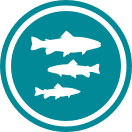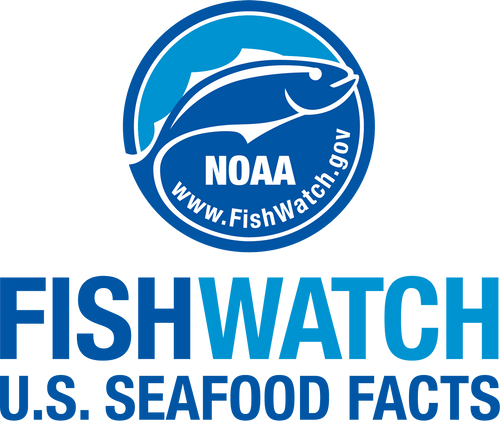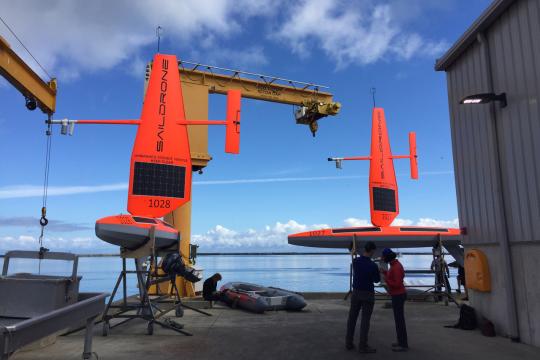 School of anchovy. Credit: NOAA Fisheries
School of anchovy. Credit: NOAA Fisheries
School of anchovy. Credit: NOAA Fisheries
About the Species
 School of anchovy. Credit: NOAA Fisheries
School of anchovy. Credit: NOAA Fisheries
School of anchovy. Credit: NOAA Fisheries
U.S. wild-caught northern anchovies are a smart seafood choice because they are sustainably managed and responsibly harvested under U.S. regulations.

Population
The population levels of the northern and southern stocks are unknown, but management measures are in place.

Fishing Rate
Not subject to overfishing.

Habitat Impact
The gear used to catch northern anchovies is used at the surface and has little impact on habitat.

Bycatch
Bycatch is low because the gear is selective.
Population Status
There are two stocks of northern anchovy: A northern and a southern stock. Formal stock assessments are not conducted for either stocks, but data is collected to help monitor the populations, including ship-based surveys that have been completed annually since 2016.
- The northern subpopulation has never been formally assessed, but is thought to be abundant. The stock is not subject to overfishing based on 2022 catch data.
- The population status of the southern stock was assessed in 2022, but there is not enough information to determine the population size so the population status is unknown, but is thought to be abundant. The stock is not subject to overfishing based on 2022 catch data. Summary stock assessment information can be found on Stock SMART.
Appearance
- Northern anchovies are small, compressed fish with long snouts that overhang a large mouth.
- They are bluish-green above and silvery below, and adults have a faint silver stripe on the side.
Biology
- Northern anchovies grow quickly, up to about 7 inches.
- They have a short life cycle; they are able to spawn after 2 years and rarely live longer than 4 years.
- They have high natural mortality; each year 45 to 55 percent of the total stock would die of natural causes if no fishing occurred.
- Northern anchovies spawn throughout the year, with peak activity from February to April.
- Females release batches of eggs every 7 to 10 days. The eggs hatch in 2 to 4 days, depending on the temperature of the water.
- Northern anchovies feed on plankton (tiny floating plants and animals).
- They are an important part of the food chain for other fish species, including many recreationally and commercially important fish, as well as birds and marine mammals.
Where They Live
Range
- Northern anchovies are found from British Columbia to Baja California and in the Gulf of California.
- Northern anchovies are divided into two sub-populations in the United States:
- The northern sub-population is found off Oregon and Washington.
- The central sub-population ranges from California to Baja California, Mexico.
Habitat
- Anchovies form large, dense schools near the ocean surface.
- Anchovy schools move short distances along the shore and offshore.
Fishery Management
- NOAA Fisheries and the Pacific Fishery Management Council manage this fishery.
- Northern anchovy is managed under the Coastal Pelagic Species Fishery Management Plan:
- Monitored through landings data. If landings increase significantly, or exceed the annual catch limit, then managers may make management changes.
- Limits on the number and capacity of vessels in the fishery.
- Regulations to reduce bycatch.
- Federal management is coordinated with state fisheries management agencies so that regulations are consistent in state waters (within 3 miles of shore). All states follow federal regulations but some have additional regulations.
Harvest
- In 2022, commercial landings of northern anchovy totaled 3.5 million pounds and were valued at $680,000, according to the NOAA Fisheries commercial fishing landings database.
- Northern anchovies are generally harvested in the United States with round haul gear.
- Northern anchovies have been fished off the West Coast since at least 1916. The fishery was small until the Pacific sardine fishery collapsed in the 1940s and 1950s. Processors began canning anchovies instead of sardines, and fishermen started harvesting more anchovies.
- Consumer demand for anchovies decreased after the sardine population recovered, and the commercial fishery for northern anchovies gradually declined.
- Today, northern anchovies are used mainly for bait in other fisheries and sometimes processed into fish meal.
Scientific Classification
- Northern anchovies are found from British Columbia to Baja California and in the Gulf of California.
- Northern anchovies are divided into two sub-populations in the United States:
- The northern sub-population is found off Oregon and Washington.
- The central sub-population ranges from California to Baja California, Mexico.
- Anchovies form large, dense schools near the ocean surface.
- Anchovy schools move short distances along the shore and offshore.
Fishery Management
- NOAA Fisheries and the Pacific Fishery Management Council manage this fishery.
- Northern anchovy is managed under the Coastal Pelagic Species Fishery Management Plan:
- Monitored through landings data. If landings increase significantly, or exceed the annual catch limit, then managers may make management changes.
- Limits on the number and capacity of vessels in the fishery.
- Regulations to reduce bycatch.
- Federal management is coordinated with state fisheries management agencies so that regulations are consistent in state waters (within 3 miles of shore). All states follow federal regulations but some have additional regulations.
Harvest
- In 2022, commercial landings of northern anchovy totaled 3.5 million pounds and were valued at $680,000, according to the NOAA Fisheries commercial fishing landings database.
- Northern anchovies are generally harvested in the United States with round haul gear.
- Northern anchovies have been fished off the West Coast since at least 1916. The fishery was small until the Pacific sardine fishery collapsed in the 1940s and 1950s. Processors began canning anchovies instead of sardines, and fishermen started harvesting more anchovies.
- Consumer demand for anchovies decreased after the sardine population recovered, and the commercial fishery for northern anchovies gradually declined.
- Today, northern anchovies are used mainly for bait in other fisheries and sometimes processed into fish meal.
Scientific Classification
| Kingdom | Animalia | Phylum | Chordata | Class | Actinopterygii | Order | Clupeiformes | Family | Engraulidae | Genus | Engraulis | Species | mordax |
|---|
Last updated by NOAA Fisheries on 09/06/2024
Featured News
 Nate Mantua off the coast of Sonoma County on the New Sea Angler, a charter boat based in Bodega Bay that is part of the cooperative salmon sampling program. Photo courtesy of Nate Mantua.
Nate Mantua off the coast of Sonoma County on the New Sea Angler, a charter boat based in Bodega Bay that is part of the cooperative salmon sampling program. Photo courtesy of Nate Mantua.
 NOAA Ship Reuben Lasker, a fisheries survey vessel, departed San Diego in early July to assess coastal pelagic species such as sardine and anchovy. Credit: Paul Hillman/NOAA Fisheries
NOAA Ship Reuben Lasker, a fisheries survey vessel, departed San Diego in early July to assess coastal pelagic species such as sardine and anchovy. Credit: Paul Hillman/NOAA Fisheries
Seafood Facts

Are Northern Anchovies Sustainable?
U.S. wild-caught northern anchovies are a smart seafood choice because they are sustainably managed and responsibly harvested under U.S. regulations.
Availability
Year-round.
Source
Wild-caught off Washington, Oregon, and California.
Taste
Canned or salted anchovies have a pronounced, salty tang, and fresh anchovies have a rich but subtle taste and a soft texture.
Texture
Unprocessed anchovies have soft flesh but canned meat is firm.
Color
Canned anchovies packed in oil are blush red, a result of the salt-curing process. The meat of unprocessed anchovies is gray and becomes off-white when cooked.
Health Benefits
Anchovies are high in calcium, iron, niacin, phosphorus, and selenium but are also high in cholesterol.
Nutrition Facts
Servings: 1; Serving Weight: 100 g; Calories: 131; Protein: 20.35 g; Total Fat: 4.84 g; Total Saturated Fatty Acids: 1.282 g; Carbohydrate: 0 g; Total Sugars: 0 g; Total Dietary Fiber: 0 g; Cholesterol: 60 mg; Selenium: 36.5 mcg; Sodium: 104 mgMore Information
Last updated by NOAA Fisheries on 09/06/2024
Seafood News
 Fish on display at the market. Credit: Shutterstock
Fish on display at the market. Credit: Shutterstock
 A signboard thanking patrons at Tuna Harbor Dockside Market in San Diego. Credit: Tuna Harbor Dockside Market.
A signboard thanking patrons at Tuna Harbor Dockside Market in San Diego. Credit: Tuna Harbor Dockside Market.
 Credit: NOAA Fisheries/Brianna Shaughnessy
Credit: NOAA Fisheries/Brianna Shaughnessy
Documents
Proceedings of the 22nd Annual Trinational Sardine & Small Pelagics Forum Virtual Event - May 2, 2022
Proceedings of the virtual 22nd Annual Trinational Sardine and Small Pelagics Forum (TSF), hosted…
Proceedings Of The 2021 Trinational Sardine & Small Pelagics Forum (PDF, 37 pages)
Proceedings of the virtual 21st Annual Trinational Sardine and Small Pelagics Forum (TSF), hosted…
Proceedings of the 2019 Trinational Sardine & Small Pelagics Forum
Proceedings of the 20th Annual Trinational Sardine and Small Pelagics Forum (TSF) held on December…
Research
Trinational Sardine and Small Pelagics Forum
The Trinational Sardine and Small Pelagics Forum comprises sectors of government, academia, and industry from Mexico, Canada, and the United States to collaborate in improving coast-wide stock assessments.
Fisheries Oceanography in the California Current
The Fisheries Oceanography Program, composed with the Ichthyoplankton Ecology and Ship Operations groups, work to contribute to the understanding of the effects of climate change and climate variability on pelagic fisheries, with a primary focus on the…
Experimental Aquarium at the Southwest Fisheries Science Center
The aquarium at the Southwest Fisheries Science Center facilitates research across many species, including the endangered black and white abalone.
Advanced Survey Technologies for Assessments in the California Current Ecosystem
The Advanced Survey Technologies program supports ecosystem-based fisheries management through new or innovative uses of sampling technologies, including: multi-frequency acoustic systems, remotely operated vehicles, instrumented buoys, and instrumented…
Last updated by NOAA Fisheries on 09/06/2024


